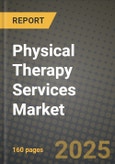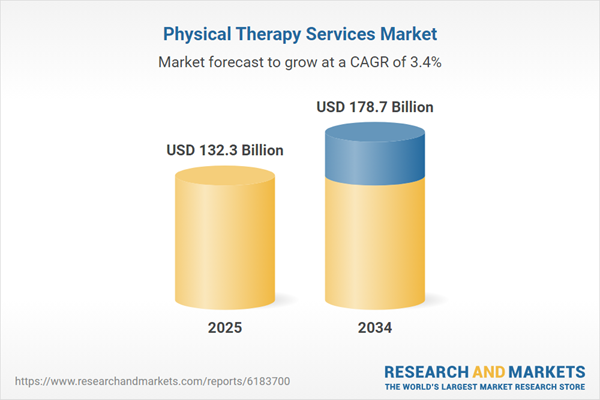Physical Therapy Services Market
Physical therapy (PT) services encompass prevention, assessment, and rehabilitation for musculoskeletal, neurological, cardiopulmonary, and pediatric conditions delivered across outpatient clinics, hospital-based departments, home health, employer sites, and virtual care. Core demand is anchored in post-operative orthopedic recovery, sports and occupational injuries, chronic back and neck pain, stroke and neurodegenerative conditions, balance/fall prevention, women’s health, and cardiometabolic rehabilitation. Providers increasingly operate hybrid models that blend in-person sessions with digital triage, remote therapeutic monitoring, and app-guided home-exercise programs to improve adherence and access. On the supply side, clinic networks pursue standard operating playbooks, outcome benchmarking, and payer contracting strategies, while hospitals expand early-mobility and enhanced recovery pathways.Key trendlines include: migration of low-acuity cases to outpatient and home settings; wider adoption of clinical pathways and functional outcome metrics to support value-based arrangements; and integration of wearables, computer-vision motion analysis, and algorithmic progression to personalize dosing. Employer and insurer partnerships channel members to PT first for musculoskeletal complaints, aiming to avoid unnecessary imaging and surgery. Competitive dynamics feature national and regional clinic networks, hospital outpatient departments, specialist practices (sports, pediatric, pelvic, vestibular, oncology, lymphedema), and digital MSK platforms partnering with payers and self-insured employers. Execution challenges remain - licensure and referral rules, uneven reimbursement for tele-rehab, therapist shortages and burnout, and variability in plan design and patient adherence. Nonetheless, aging populations, rising chronic MSK burden, and payer incentives to shift from procedures to conservative care position PT services as a cornerstone of cost-effective recovery, functional independence, and return-to-work outcomes.
Physical Therapy Services Market Key Insights
- PT-first pathways gain traction. Employers and payers steer MSK cases to PT as an initial intervention, reducing imaging and invasive procedures. Success depends on rapid access, standardized triage, and clear escalation criteria.
- Hybrid care is the new default. Clinics pair in-person visits with remote monitoring, asynchronous coaching, and app-based HEPs. Hybrid models widen reach, smooth no-shows, and maintain continuity during travel or flare-ups.
- Outcomes and value contracts mature. Functional measures, patient-reported outcomes, and episode benchmarks underpin risk-sharing and bundled arrangements. Transparent reporting becomes a differentiator in network selection.
- Clinical specialization deepens. Programs in pelvic health, vestibular and concussion, oncology/lymphedema, hand therapy, and pediatric neuro expand case mix and referral stickiness while defending rates.
- Digital MSK platforms integrate with bricks-and-mortar. Virtual triage, motion capture, and adherence analytics funnel appropriate cases to clinics and keep others virtual, improving capacity utilization and therapist productivity.
- Workforce strategy is pivotal. Recruiting, residency tracks, mentorship, and technician/assistant deployment mitigate shortages. Scheduling analytics and documentation automation address burnout and improve throughput.
- Home-based and community PT expands. Post-acute and aging-in-place models rely on mobile therapists and remote monitoring to prevent readmissions and falls, supported by caregiver education and simple equipment.
- Patient experience drives retention. Self-service scheduling, upfront benefits checks, digital reminders, and clear goal-setting lift adherence. Nurturing long-term wellness memberships stabilizes volume beyond episodes.
- Compliance and governance tighten. Documentation integrity, plan-of-care reviews, privacy, and anti-fraud controls shape payer relations. Providers invest in audit readiness and clinical decision support.
- Consolidation continues selectively. Regional roll-ups and hospital-clinic joint ventures scale contracting power and analytics while preserving local referral relationships and niche expertise.
Physical Therapy Services Market Reginal Analysis
North America
Demand is propelled by high MSK prevalence, aging populations, and employer-sponsored benefits. PT-first models, direct access in many jurisdictions, and remote therapeutic monitoring codes support hybrid care economics, though payment parity for tele-rehab remains uneven. Consolidation by private-equity-backed networks coexists with strong regional independents. Hospitals emphasize early mobility and enhanced recovery, while payers push site-of-care shifts to outpatient and home settings. Workforce shortages drive investment in assistants, documentation tools, and flexible scheduling.Europe
Public and mixed-payer systems prioritize guideline-based conservative care and community rehabilitation. Primary-care integration enables rapid MSK triage by physiotherapists, reducing specialty backlog. Reimbursement for digital components is expanding but country-specific, with strong data-privacy expectations. Aging demographics sustain neuro and fall-prevention programs, while return-to-work pathways coordinate with occupational health. Workforce mobility, multilingual tooling, and cross-border credentialing influence staffing strategies for networks operating across regions.Asia-Pacific
Aging societies and rising sports/orthopedic demand underpin growth in Japan, Australia, and New Zealand, where advanced scopes of practice and insurer acceptance support mature clinic models. China and India scale private outpatient PT and hospital rehab units, with cash-pay and supplemental insurance common. Tele-rehab adoption is increasing in urban centers, while rural access is addressed through mobile clinics and community partnerships. Employer wellness and ergonomics programs expand in manufacturing and tech corridors.Middle East & Africa
Investment flows into rehabilitation centers within tertiary hospitals and private networks, especially in Gulf countries, with medical tourism boosting sports and post-operative programs. Public initiatives target stroke, trauma, and pediatric rehab capacity. Workforce localization and training partnerships address therapist scarcity. In Africa, access remains uneven; donor-supported programs and NGO collaborations complement private clinics in metros. Remote supervision and low-cost home-exercise solutions bridge geographic gaps.South & Central America
Urban markets in Brazil, Mexico, Chile, and Colombia anchor demand via private insurance and growing corporate health programs. Public systems emphasize post-acute and neuro rehab, though capacity constraints create waitlists and cash-pay options. Clinic networks focus on standardized pathways for ortho and sports, while home-based PT supports aging-in-place. Currency volatility and reimbursement delays heighten the importance of revenue-cycle discipline, diversified payor mix, and partnerships with hospital discharge teams.Physical Therapy Services Market Segmentation
By Application
- Orthopedic Therapy
- Geriatric Therapy
- Cardiopulmonary Therapy
- Pediatric Therapy
- Neurological Therapy
- Womens Health
- Others
By Setting
- Outpatient Clinics
- Hospitals
- Home Healthcare
- Others
By Payer
- Public Insurance
- Private Insurance
- Out of Pocket
Key Market players
Select Medical, U.S. Physical Therapy Inc., ATI Physical Therapy, Athletico, Upstream Rehabilitation, Confluent Health, PT Solutions, Professional Physical Therapy, NovaCare Rehabilitation, Kessler Rehabilitation Center, FYZICAL Therapy & Balance Centers, BenchMark Physical Therapy, HSS Rehabilitation, Ramsay Health Care, BupaPhysical Therapy Services Market Analytics
The report employs rigorous tools, including Porter’s Five Forces, value chain mapping, and scenario-based modelling, to assess supply-demand dynamics. Cross-sector influences from parent, derived, and substitute markets are evaluated to identify risks and opportunities. Trade and pricing analytics provide an up-to-date view of international flows, including leading exporters, importers, and regional price trends.Macroeconomic indicators, policy frameworks such as carbon pricing and energy security strategies, and evolving consumer behaviour are considered in forecasting scenarios. Recent deal flows, partnerships, and technology innovations are incorporated to assess their impact on future market performance.
Physical Therapy Services Market Competitive Intelligence
The competitive landscape is mapped through proprietary frameworks, profiling leading companies with details on business models, product portfolios, financial performance, and strategic initiatives. Key developments such as mergers & acquisitions, technology collaborations, investment inflows, and regional expansions are analyzed for their competitive impact. The report also identifies emerging players and innovative startups contributing to market disruption.Regional insights highlight the most promising investment destinations, regulatory landscapes, and evolving partnerships across energy and industrial corridors.
Countries Covered
- North America - Physical Therapy Services market data and outlook to 2034
- United States
- Canada
- Mexico
- Europe - Physical Therapy Services market data and outlook to 2034
- Germany
- United Kingdom
- France
- Italy
- Spain
- BeNeLux
- Russia
- Sweden
- Asia-Pacific - Physical Therapy Services market data and outlook to 2034
- China
- Japan
- India
- South Korea
- Australia
- Indonesia
- Malaysia
- Vietnam
- Middle East and Africa - Physical Therapy Services market data and outlook to 2034
- Saudi Arabia
- South Africa
- Iran
- UAE
- Egypt
- South and Central America - Physical Therapy Services market data and outlook to 2034
- Brazil
- Argentina
- Chile
- Peru
Research Methodology
This study combines primary inputs from industry experts across the Physical Therapy Services value chain with secondary data from associations, government publications, trade databases, and company disclosures. Proprietary modeling techniques, including data triangulation, statistical correlation, and scenario planning, are applied to deliver reliable market sizing and forecasting.Key Questions Addressed
- What is the current and forecast market size of the Physical Therapy Services industry at global, regional, and country levels?
- Which types, applications, and technologies present the highest growth potential?
- How are supply chains adapting to geopolitical and economic shocks?
- What role do policy frameworks, trade flows, and sustainability targets play in shaping demand?
- Who are the leading players, and how are their strategies evolving in the face of global uncertainty?
- Which regional “hotspots” and customer segments will outpace the market, and what go-to-market and partnership models best support entry and expansion?
- Where are the most investable opportunities - across technology roadmaps, sustainability-linked innovation, and M&A - and what is the best segment to invest over the next 3-5 years?
Your Key Takeaways from the Physical Therapy Services Market Report
- Global Physical Therapy Services market size and growth projections (CAGR), 2024-2034
- Impact of Russia-Ukraine, Israel-Palestine, and Hamas conflicts on Physical Therapy Services trade, costs, and supply chains
- Physical Therapy Services market size, share, and outlook across 5 regions and 27 countries, 2023-2034
- Physical Therapy Services market size, CAGR, and market share of key products, applications, and end-user verticals, 2023-2034
- Short- and long-term Physical Therapy Services market trends, drivers, restraints, and opportunities
- Porter’s Five Forces analysis, technological developments, and Physical Therapy Services supply chain analysis
- Physical Therapy Services trade analysis, Physical Therapy Services market price analysis, and Physical Therapy Services supply/demand dynamics
- Profiles of 5 leading companies - overview, key strategies, financials, and products
- Latest Physical Therapy Services market news and developments
Additional Support
With the purchase of this report, you will receive:- An updated PDF report and an MS Excel data workbook containing all market tables and figures for easy analysis.
- 7-day post-sale analyst support for clarifications and in-scope supplementary data, ensuring the deliverable aligns precisely with your requirements.
- Complimentary report update to incorporate the latest available data and the impact of recent market developments.
This product will be delivered within 1-3 business days.
Table of Contents
Companies Mentioned
- Select Medical
- U.S. Physical Therapy Inc.
- ATI Physical Therapy
- Athletico
- Upstream Rehabilitation
- Confluent Health
- PT Solutions
- Professional Physical Therapy
- NovaCare Rehabilitation
- Kessler Rehabilitation Center
- FYZICAL Therapy & Balance Centers
- BenchMark Physical Therapy
- HSS Rehabilitation
- Ramsay Health Care
- Bupa
Table Information
| Report Attribute | Details |
|---|---|
| No. of Pages | 160 |
| Published | November 2025 |
| Forecast Period | 2025 - 2034 |
| Estimated Market Value ( USD | $ 132.3 Billion |
| Forecasted Market Value ( USD | $ 178.7 Billion |
| Compound Annual Growth Rate | 3.4% |
| Regions Covered | Global |
| No. of Companies Mentioned | 15 |









